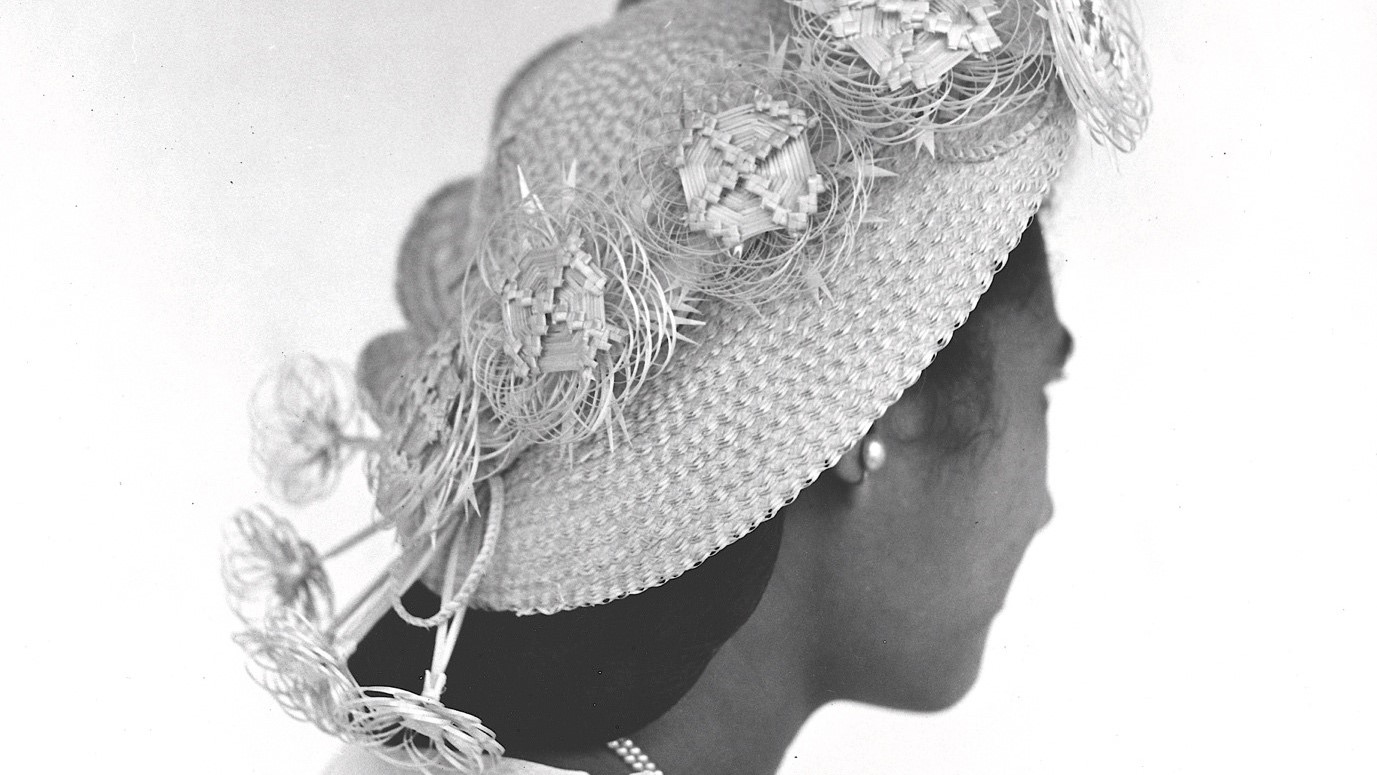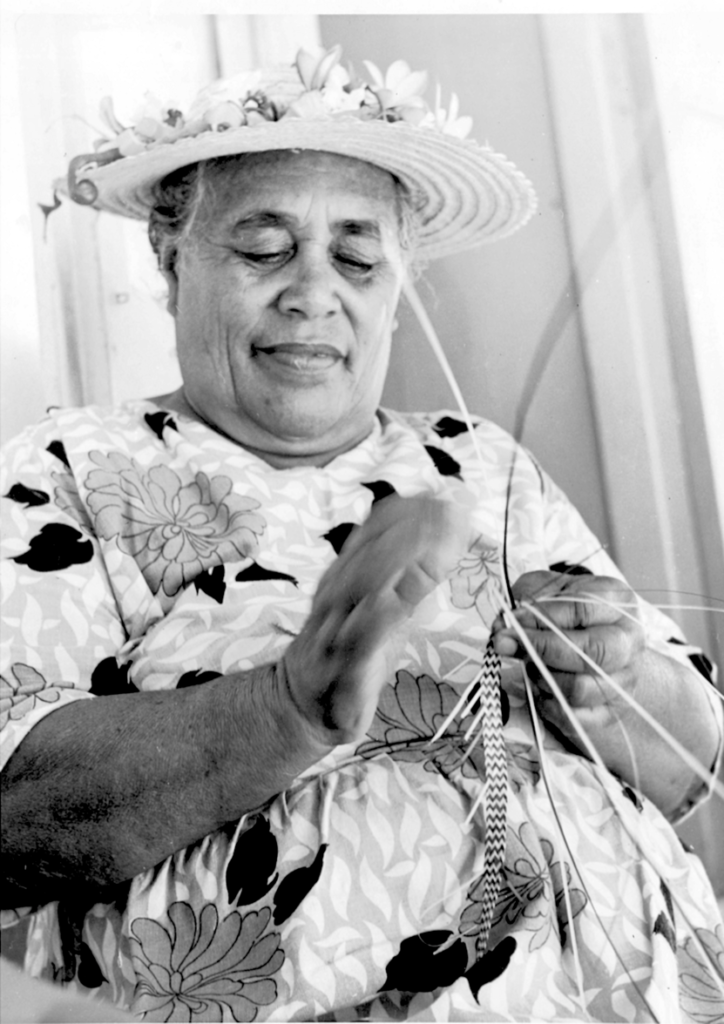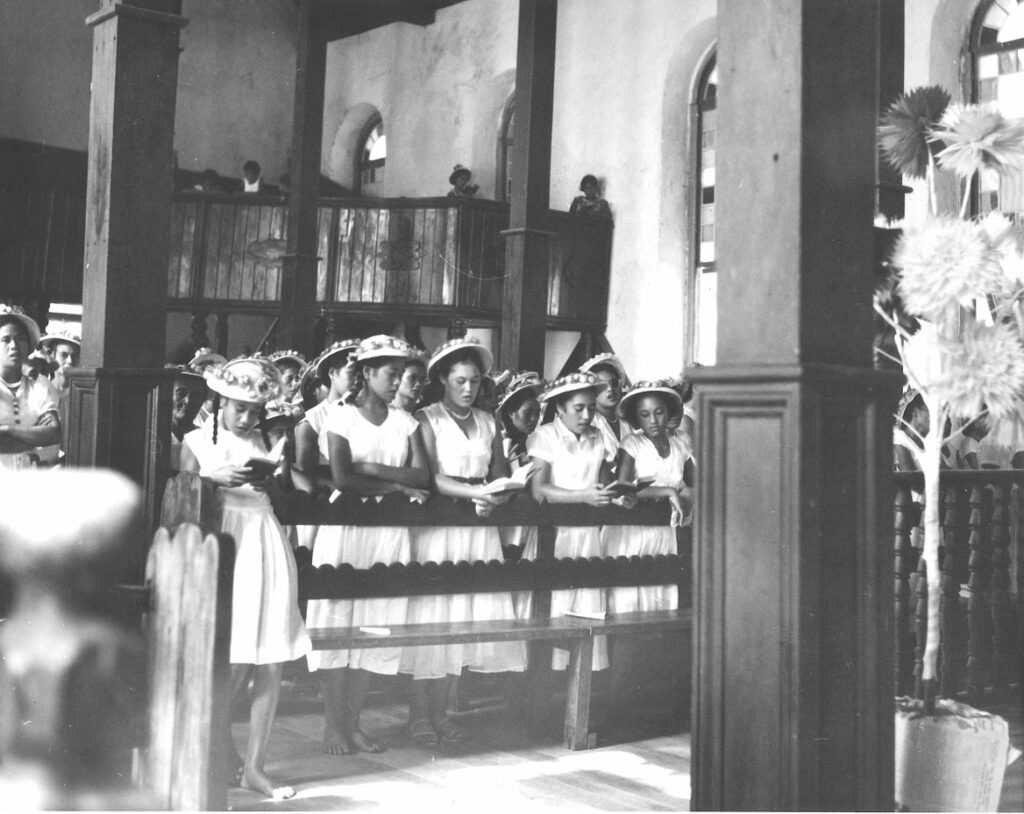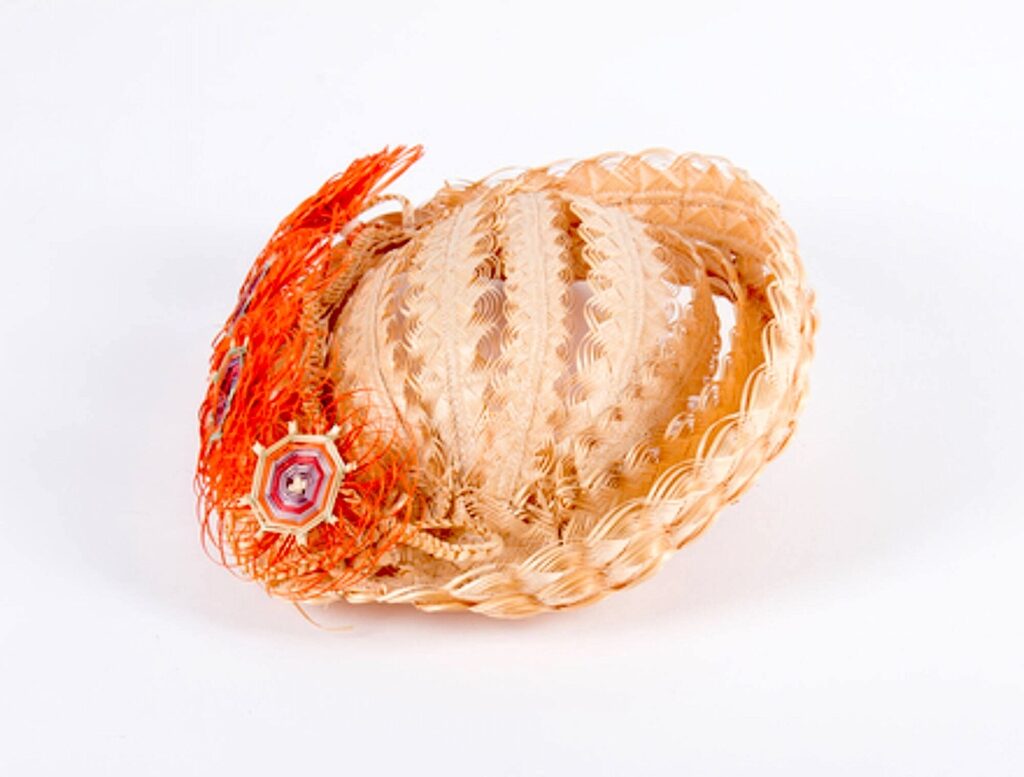Mangaian chic – pare tō fashion hats from the 1950s
Saturday 4 June 2022 | Written by Rod Dixon | Published in Features, Weekend

A Mangaia pare to from c. 1957 with typical flower and ‘spider’s web’ decoration (photo; D. S. Marshall Archive, USP Cook Islands)/22060320
The discovery in Washington DC of a cache of 27 Mangaian reed hats or pare tō, dating from 1958, has reignited local interest in how these extraordinary fashion items were produced, writes Rod Dixon.
In the second month of the Māori year, known as Ōtunga, the “hills are covered with reeds in blossom” while in the fifth month known as Muri‘ā‘ā, the old calendar notes “ruru anga kāka‘o” - “the reed blossoms are scattered by a late blow” presaging winter.
These months – roughly January to April – are the flowering season of the kāka‘o reed. Allan Tuara recalls that during these months, “Men, women and children wandered over the Mangaian hills to pull out the kāka‘o.”
Mrs. Papaiti Parima remembers making early morning trips with her mother (Mama Noora'a, known as ‘Makeni’) up to the hills near their pineapple plantations in puna Kei'ā . “Makeni knew exactly where to go during kāka‘o flowering season – the shady and flat areas that produced the longer stems of kāka‘o. For the weavers, the longer the reed the better.”
The unwanted flowering ends of the kāka‘o were cut off and the remaining stems saved in a bundle. The stems were later split in half and the core of the stem exposed. Mrs. Parima remembers sitting in a shady spot in the hills, biting through the stem, then using her hands to pull the reed in half.
After a day in the hills, the women and children returned home with their bundles of split reeds, the size of the bundle indicating the success of the day’s harvest.
Later, the split reeds would be placed in a tray inside a box, usually a returned Makatea worker’s trunk (the wooden box issued to indentured workers on arrival at Makatea Island to keep their clothing and small items safe). These so-called “Makatea suitcases” or a standard household “glory box” provided an ideally-sized container for bleaching the kāka‘o reeds.

Some yellow sulpur powder was placed in a used corned beef tin containing hot embers from a cooking fire. The smouldering sulphur was then placed under the tray of split reeds and the lid of the box closed. Burning sulphur generates sulphur dioxide which has the smell of burnt matches (matches being treated with sulphur to speed ignition). The coined-word māti or ‘match’ described both the yellow sulphur powder and the sulphur treatment process.
The box was kept closed for two or three days, sometimes longer. Sulphur dioxide is, among other things, a reducing bleach and a fumigant. The māti process whitened the reeds, now called tōtea (white tō) while also fumigating them against mildew, fungus, insects and rats.
After this, the reeds were cleaned of their i’o or core. Papaiti Parima recalls using the to'e pare or hat block as a platform to scrape off the inner white pith with a knife. It is the outer skin of the kaka'o that is used for weaving.
The outer skin was scraped on both sides at the same time to make the reed pliable. The result was a 6-7mm wide pliable ribbon. These ribbons were rolled tightly and tied together and stored for future use. When needed, they were peeled off singly and, if thinner strips were required, for example, in making rosettes for a hatband, they were stripped to size with the point of a needle.
The strips of tō were also dyed if the hat design required it. Commercial dyes were used, as well as the purple bark sap of the ūtū, the mountain plaintain and dyes (pink, green and purple) obtained from immersing office carbon paper in boiling water.
The season for the flowering and harvesting of the kāka‘o reed coincided with Christmas and the April ‘uapou. The ‘uapou is an after-church meeting held as a rule every Sunday, but more recently only on ‘special’ Sundays.
The 'uapou traditionally takes place in the Mission House, or in the meeting houses of Mangaia’s six puna. In the formal part of the ‘uapou, the leader puts forward a passage from the Bible or a religious text and members of the group attempt individually to explain the meaning of the passage. At the end of the 'uapou, the leader attempts to encompass all the views expressed as a shared understanding.
The word 'uapou denotes striving to find knowledge. Rōta‘i is to unite in body, mind and spirit, to be of one purpose. In the 'uapou, the puna group focuses its thoughts upon a single subject or purpose, individually, then collectively.

For the Christmas and April 'uapou, a ta'unga rāranga pare (expert hat maker) from each puna was tasked with creating a new hat design. This design was then copied and worn by all the women of the puna – each of the six puna having its own distinct design – a sign of the puna women unified in single purpose (rōta‘i).
The six new designs were premiered at the April and Christmas 'uapou – a total of 12 new hat designs every year.
Church hats had their origin as a symbol of conversion to Christianity. Rev, William Ellis dates the local manufacture of distinctively European-style bonnets and hats to early 1820 on Raiatea, under the instruction of the missionary wives Mary Williams and Martha Threlkeld. He describes the first hats as made from the bast of the purau (Hibiscus tiliaceus). The fashion later spread to Huahine.
In 1821 Rev. John Williams, missionary at Raiatea, extended the diocese of the Society Islands mission to include the southern Cook Islands commencing at Aitutaki, followed by Ngaputoru, then Rarotonga and finally Mangaia in 1824. The introduction of hats and bonnets followed thereafter.
The first missionaries on Aitutaki were two single men, Vahapata from Raiatea and Papehia from Bora Bora (trained by Williams at Raiatea). It was from these two men that the Aitutakians first learned to make European style hats.
The first to formally teach European style bonnet making to the Rarotongans were, as on Aitutaki, two men, Papeiha and Tiberio also from Raiatea. Rev. John Williams noted that they were not particularly skilled in the art – “Although the teachers were both single men, they had taught them to make bonnets; but I must add that their taste in forming the shape did not admit of equal commendation … These deficiencies, however, were supplied by (the missionary wives) Mrs. (Elizabeth) Pitman (1) and Mrs. (Mary) Williams who made some hundreds of bonnets and rendered many of the natives proficient in the art” (1838;166).

Later, as the Cook Islands became more regularly visited by whalers and traders and as Cook Islands men began to travel widely as the crews of these ships, interest in locally produced bonnets gave way to a demand for hats in contemporary overseas styles.
In 1859 the Rev Aaron Buzacott noted that, of the money earned by Rarotongans from providoring, “the greater part is spent in purchasing goods from American vessels, small traders which trade among the islands, and resident merchants, such as cotton prints, blue stout, silks, hats, bonnets, shawls, umbrellas, &c., &c.” (Sydney Morning Herald, 1 March, 1859).
In 1871, a frequent visitor to Rarotonga observed “…(T)he fact of many of the men having visited Tahiti, and even Sydney and Auckland and brought back accounts of the habits and attire of the Europeans in those places has caused a revolution in the sumptuary laws (personal expenditure) of Rarotonga. Everyone wears now what he or she pleases, and they go the whole hog as far as their means will permit; the snuff-coloured smocks and green cotton umbrellas, and hideous coal-scuttle bonnets of the early missionary regime, are consigned to the limbo of forgotten absurdities, and the people have made a stampede in the opposite direction.” (‘Master Mariner’, 1871 a).
Fashions were now entering the Cook Islands from every corner of the globe to which Cook Islands seamen voyaged or from which visiting vessels set sail.
On Mangaia, hats continued to be made of local material but were lavishly decorated with imported ribbons and artificial flowers. Visiting Mangaia in 1904, the Irish writer Beatrice Grimshaw, observed that, almost every penny that Mangaian’s earned from the fresh fruit trade was “spent in trade-finery…. On Sundays, the churches are a very flower-garden of frippery, the men turning out in the most brilliant of shirts, ties, and suits, the women decking themselves in long loose robes of muslin, sateen, or cheap silk, coloured in the most screaming hues—pea-green, royal blue, scarlet, and orange being all strong favourites. Their hats, made by themselves out of silky arrowroot fibre, are often trimmed with the costliest ribbons and artificial flowers, and even with ostrich plumes to the value of two or three pounds.”
By the late 1930 and early 1940s, a new style of hat, with an elaborate headband came into fashion on Mangaia. This was the pare tō made from long braids of plaited kaka’o or tō.

In making pare tō, the crown or to'e pare was formed first. The braided tō, placed on the to'e pare (hat block), was carefully twisted round the block to form the shape of the crown. The braids were then sewn together by hand. The crown was usually left plain, without decoration. The brim (tau pare) was sewn using a Singer treadle sewing machines which were common in almost every home.
Next the decorative elements were added. A tākai or band generally comprised a series of rosettes, backed by a finely spun web of very thin tō. The rosettes were referred to by the names of the flowers they represented – tiare māori (gardenia), mātirīta (the marguerite daisy), etc. The tassels were known as purūmu, the coined word for ‘broom’. The small rounded decorative shapes were known as poroporo – referring to the shrub (Solanum americanum) which has clusters of small black berries. The fine plaited strands of tō used for loops and bows were known as vīvī or ‘chains’.
A white hat, once completed, would be bleached again (minus its decorative band) in the “Makatea suitcase” or bleaching box. A cloth lining was added to some hats.
Jean Tekura Mason recalls that, in their heyday, Mangaian pare tō “were the most prestigious of hats and every Cook Islands’ woman aspired to own one”.
“My grandmother, the former Mata Metuaiti/Tauri (Ngapoko Kairae) only had one and it was the most precious thing she owned. She’d take it off immediately it started to drizzle. I remember thinking how funny and flat they looked sitting jauntily on women’s heads because they weren’t made to fit the whole head at all. These were the days women were still using hat pins (they needed them to fix them to their hair). But I sensed the hats were not only hard to get but hard to make and looked quite delicate.”
Influenced by trends from Tahiti, the pare tō was superseded in the 1970s by the pare rīpene and the pare lafia and more recently by the rito hat. Today, only a few remain in private hands and museum collections.
Recently a cache of 27 have come to light in Washington DC. These were pare tō gifted to the anthropologist Don Marshall and his wife and children during field work on Mangaia in 1958.
Their discovery has reignited interest on Mangaia where the Mangaian Historical Society is preparing a book placing on permanent record this extraordinary mid 20th century fashion wave. The book will be available in September of this year.













































Comments
Cameron Scott on 10/06/2022
Very interesting story.